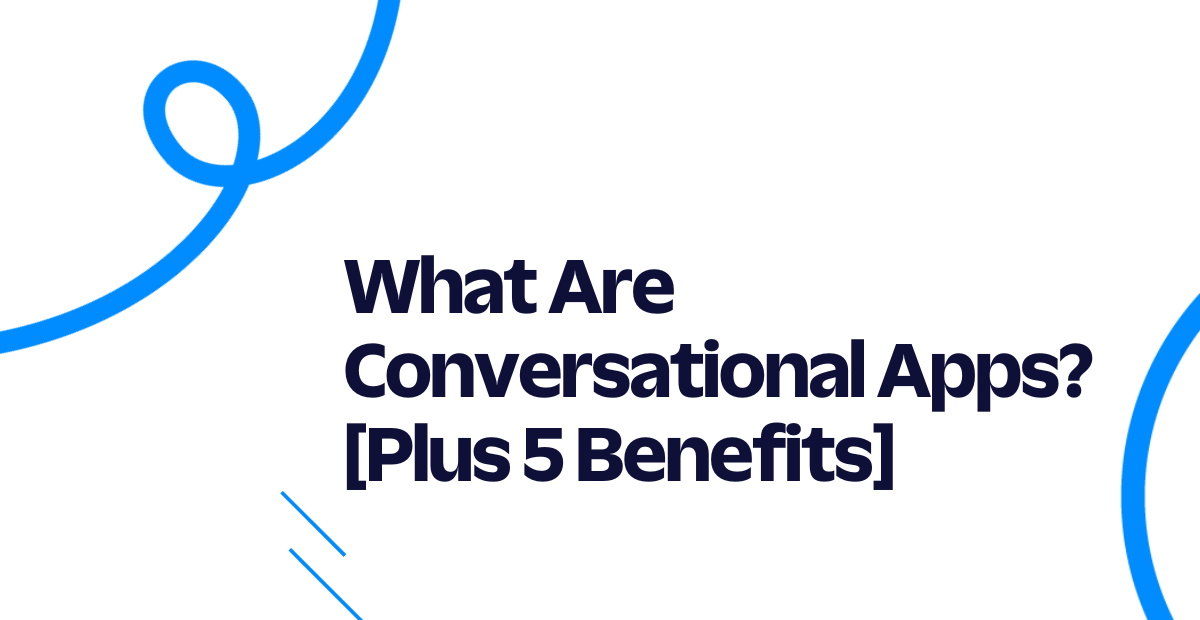What Are Conversational Apps? [Plus 5 Benefits]
Time to read: 5 minutes

The way businesses interact with customers has changed quickly in the past few years. Customers used to pick up the phone or send an email to get in touch with a business, but today, more and more of these interactions happen on conversational apps.
If this term is new to you, don’t worry. This post will explain what conversational apps are, how businesses can use them, and the top benefits of conversational customer engagement.
What are conversational apps?
Conversational apps are computer programs businesses use to engage customers on platforms like SMS, WhatsApp, and live chat. These apps enable conversational messaging—interactions between customers and businesses initiated by the customer on their preferred messaging platform.
This interaction benefits both parties. On the customer’s end, they can choose the most convenient channel to connect with businesses. And on the agent's side, they can provide efficient support on various channels from a single platform.
Conversational messaging platforms typically use a combination of artificial intelligence (AI), interactive features, and live agents to address customer needs quickly, from answering simple questions to making changes to their account and beyond.
Features can include:
- Buttons for customer self-service resources or reaching the right agent
- Calendars for appointment scheduling
- Rating scales for customer feedback
- Payment integrations for ease of payment
- And more
How can businesses and customers use conversational apps?
Businesses can use conversational messaging to engage customers in various ways, including:
- Customer support
- Sales and customer acquisition
- Relationship management and customer retention
For customers, there are various ways to start the conversation. They can connect with businesses by:
- Clicking on a click-to-message ad
- Starting a live chat on the business’ website or app
- Texting the business on their preferred messaging app
What are the benefits of using conversational apps?
Conversational apps can make engagement more convenient for businesses and customers alike. Here are a few ways your business can benefit:
1. Support customers on their preferred channels
Many customers today shudder at the thought of calling customer service when they just want an answer to a simple question. Need proof? In our 2022 State of Customer Engagement Report, we found that 36% of customers would rather endure some uncomfortable experiences, like losing their internet for a day, than call customer support.
Customers’ preference for messaging is loud and clear: 80% want brands to offer conversational messaging, and 74% think it makes the purchasing experience easier.
One of the reasons they like messaging is that it gives them the power to initiate the conversation. Customers are weary of getting constant messages from businesses, leading to digital fatigue. But conversational messaging allows them to connect with businesses when and where they want. Plus, this helps build trust because customers know the business will be available when they need it.
2. Provide immediate responses
Conversational messaging can help you create a positive customer experience, which is crucial for businesses to retain customers. In fact, 56% of customers say they’ll no longer do business with a company after a poor experience.
Waiting on hold for a long time or waiting for days to get an email response are the types of poor experiences that can quickly turn away a customer. You can avoid this by leveraging automation and live agents to address the customer’s needs as quickly as possible through conversational apps.
And what’s good for your customers is good for your bottom line—88% of customers say they’re more likely to make a purchase if they can message a brand in real time.
3. Leverage automation and AI
As we’ve already mentioned, conversational apps can combine AI, automated features, and live agents strategically to:
- Meet customer needs quickly
- Make communication more efficient
- Free up agents’ time to work on more complex issues
For example, virtual agents can answer straightforward questions about operating hours and order status and complete tasks like appointment scheduling. And if the issue requires human support, the virtual agent can hand off the interaction to a live agent. With the right conversational messaging tools, you can make this transition seamless on the customer’s side.
AI and live agents make a powerful team that allows you to scale how many customers you can help daily without adding to your agents’ workload or expanding your workforce.
4. Create personalized omnichannel experiences
An omnichannel communication strategy allows you to offer support on the customer’s preferred channel, like SMS, live chat, or WhatsApp. And more importantly, it gives the agent easy access to the context of every interaction, empowering them to create a positive experience.
With Twilio Flex Conversations, a conversational app, your business can provide omnichannel communication from a single platform. This scalable app enables you to add new channels without making agents toggle between multiple dashboards or interfaces.
Plus, omnichannel platforms like Flex Conversations make it easier to provide personalized support by integrating with apps like customer relationship management software and customer data platforms such as Twilio Segment. This allows the agent to quickly access the customer’s profile and avoid asking repetitive questions.
Curious about what else you can achieve with omnichannel communication? Read The Ultimate Guide to Omnichannel.
5. Gather zero-party data
Personalization is increasingly important to customers and businesses alike—86% of consumers say personalization increases their loyalty to a brand. However, achieving personalization is becoming more challenging as third-party cookies go away.
But there’s good news: businesses can create even better personalization and generate more customer trust by gathering first-party and zero-party data. This data comes from customers’ actions on your website or information they share directly with you through forms, polls, and other interactions.
Conversational apps make it easy to gather this data because customers willingly share it with you throughout the interaction. For example, if a customer reaches out via live chat to ask about hiking boot sizing, now you know they have an interest in this product.
Then, you can personalize your marketing SMS or emails to include hiking boots. And it’s not a turn off to customers to receive your personalized campaigns because you gathered the data in a transparent way.
Build a conversational app with Flex Conversations
You may wonder if the benefits of conversational apps outweigh the work and resources needed to build one. But you don’t need to build an app from scratch. The Twilio Flex Conversations API gives you the framework to create a conversational app in a matter of days, not months.
Flex Conversations is a single API that allows you to deploy various conversational channels—including SMS, MMS, chat, and WhatsApp—from a single platform. This means agents can use one interface to connect with customers on any channel while easily accessing the necessary data and context. Read more about how Flex Conversations empowers your business to provide frictionless omnichannel experiences.
Want to dive deeper into the power of conversational messaging? Check out our report Conversational Messaging: The Next Storefront Experience, and then reach out to our experts today to get started.
Related Posts
Related Resources
Twilio Docs
From APIs to SDKs to sample apps
API reference documentation, SDKs, helper libraries, quickstarts, and tutorials for your language and platform.
Resource Center
The latest ebooks, industry reports, and webinars
Learn from customer engagement experts to improve your own communication.
Ahoy
Twilio's developer community hub
Best practices, code samples, and inspiration to build communications and digital engagement experiences.


